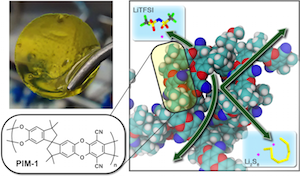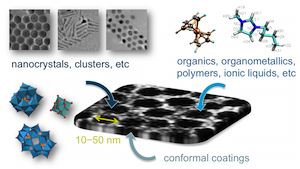Energy
Advanced Materials for Electrochemical Energy Storage

Batteries provide a unique context for materials discovery in soft and hybrid matter. Many of the battery’s key components—e.g., the active materials, electrolyte, membrane, and binder—can be organic or polymeric in nature. As battery chemistries advance the state of the art with respect to energy density, power, or safety, these components must be tailored in stride. We approach materials discovery in this design space from a molecular and architectural perspective, deeply informed by computational insights, genomics screens for properties of interest, and machine learning. With these tools, we’ve advanced new concepts and materials for ion-selective transport by membranes, network-based approaches for ion and electron transport in battery electrodes, and new solid-ion conductors with high voltage stability and low resistance.
Selected publications:
Li, L.; Pascal, T. A.; Connell, J. G.; Fan, F. Y.; Meckler, S. M.; Ma, L.; Chiang, Y.-M.; Prendergast, D.; Helms, B. A.
“Molecular Understanding of Polyelectrolyte Binders that Actively Regulate Ion Transport in Sulfur Cathodes”
Nat. Commun. 2017, 8, 2277.
[pdf]
Ward, A. L.; Doris, S. E.; Li, L.; Hughes, M. A., Jr.; Qu, X.; Persson, K. A.; Helms, B. A.
“Materials Genomics Screens for Adaptive Ion Transport Behavior by Redox-Switchable Microporous Polymer Membranes in Lithium–Sulfur Batteries”
ACS Cent. Sci. 2017, 3, 399–406.
[pdf]
Doris, S. E.; Ward, A. L.; Baskin, A.; Frischmann, P. D.; Gavvalapalli, N.; Chenard, E.; Sevov, C. S.; Prendergast, D.; Moore, J. S.; Helms, B. A.
“Macromolecular Design Strategies for Preventing Active-Material Crossover in Non-Aqueous All-Organic Redox-Flow Batteries”
Angew. Chem. Int. Ed. 2017, 56, 1595–1599.
[pdf]
Colloidal Nanocrystal Frameworks and Devices

Our research highlights the unique role of block copolymers with tailored composition and topology to direct the assembly of colloidal nanocrystals into well-ordered 3-D materials that are custom-purposed for energy storage, catalysis, sensors, etc. Porous architectures, which are revealed by simple thermal processing of the polymer, can be passivated or backfilled with a variety of functional species to reveal new properties that thrive from the prevalence of interfaces, compositional heterogeneity, and structured confinement at the mesoscale. Systems-level function under non-equilibrium conditions is also a focus, where responsive and regenerative capabilities can be configured.
Selected publications:
Helms, B.A.; Williams, T.E.; Buonsanti, R.; Milliron, D.J.
"Colloidal Nanocrystal Frameworks"
Adv. Mater. 2015, 27, 5820–5829.
[pdf]
Kim, J.; Ong, G.K.; Wang, Y.; LeBlanc, G.; Williams, T.E.; Mattox, T.M.; Helms, B.A.; Milliron, D.J.
"Nanocomposite Architecture for Rapid, Spectrally-Selective Electrochromic Modulation of Solar Transmittance"
Nano Lett. 2015, 15, 5574–5579.
[pdf]